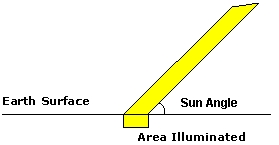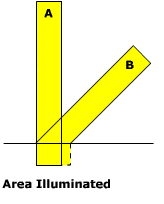InsolationThe Earth is "constantly" bathed in solar radiation. On average, the Earth receives 1368 W/m2 (1.96 ly/min) of solar radiation at the outer edge of the atmosphere, called the "solar constant". However, the actual amount received at the edge of the atmosphere and the Earth's surface varies from place to place and day to day on account of the orientation of the Earth to the Sun. The solar radiation that makes its way through the atmosphere and to the surface is called insolation. The amount of insolation received at the surface depends on 1) the sun angle, 2) day length, 3) ground slope, 4) path length, and 5) the state of the atmosphere. Sun Angle and InsolationThe amount and intensity of solar radiation reaching the Earth is affected by the tilt of the Earth's axis and its orientation as it revolves around the Sun . The sun angle at a place varies over the course of the year as a result of the constant tilt and parallelism of the earth's axis. As the sun angle decreases, light is spread over a larger area and decreases in intensity (energy input per unit area).
Figure 4.9 Sun angle and area illuminated Figure 4.10 illustrates the effect of changing sun angle on the area illuminated and intensity of heating at different sun angles. Beam A and B have the same amount of energy as they pass through the atmosphere as shown by having the same width. Beam A strikes the surface at a 90 degree angle, the highest angle a beam of light can have. It illuminates the area outlined by the solid square. Beam B strikes the surface at a lower angle than A. Its energy is spread over a larger area, the same area as A's plus the area enclosed by the dashed lines. The result of spreading the same energy out over a larger area is to reduce the intensity . Lower intensity input results in less heating.
Figure 4.10 Sun angle determines the intensity of energy. Think of the sun angle as how high the Sun appears above your horizon. The Sun's zenith angle is the angle that a beam of light makes with a line drawn perpendicular to the surface. Think of the zenith angle as how far the Sun is from being directly overhead. The most intense incoming solar radiation occurs where the Sun's rays strike the Earth at the highest angle. For any particular location this occurs at noon. This angle is referred to as the " noon sun angle". Those living in the mid to high latitudes have probably noticed that the Sun never appears directly overhead at noon on any given day. This is due to the seasonal changes in the Sun's declination, the angular distance north or south of the equator where the Sun is directly overhead. The latitude where the Sun is directly overhead at noon is the subsolar point.
|


